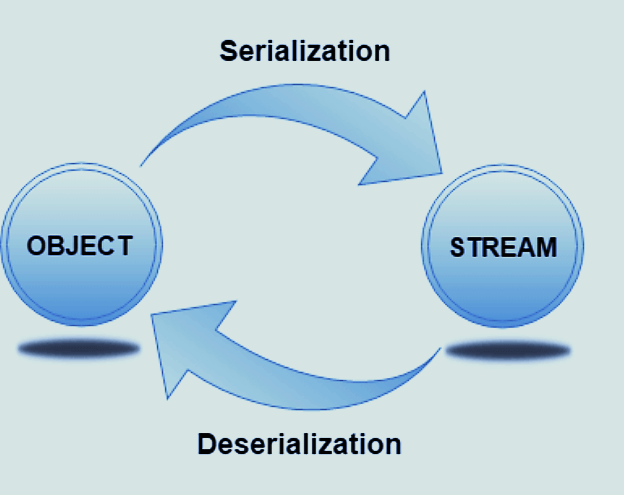Difference Between Serialization and Deserialization in Java
Fundamental ideas called serialization and deserialization are used to convert Java objects into a format that may be quickly transmitted, stored, or recreated.

Serialization
Serialization is the process of converting an object into a byte stream so that it may be sent over a network, saved in a file, or saved in a database fast. Preserving an object's state is serialization's primary goal.
Purpose
The main uses of serialisation are object storage in databases, object transmission across networks, and object state saving to files.
Use Cases:
- File-based object state storage.
- sending data over a network.
- preserving items in a database.
An object of the Person class was serialised and saved to a file (person.ser) in the Java code that was provided to demonstrate the serialisation process.
Person.java
Output:
Serialization completed. Object is saved in person.ser
Person.ser
Deserialization
Rebuilding an object from a byte stream is known as deserialization. It entails reading the byte stream and producing an object that is identical to the original in terms of state.
Use Cases
- Taking something out of a file.
- Obtaining items over a network.
- Getting items out of a database.
DeserializePerson.java
| Aspect |
Serialization |
Deserialization |
| Purpose |
Converts an object into a byte stream for storage or transmission. |
Reconstructs an object from a byte stream. |
| Output Format |
Byte stream (commonly in a file or over a network). |
Object with the same state as the original. |
| Process |
Writes object state to a byte stream. |
Reads a byte stream and creates an object. |
| Classes Involved |
ObjectOutputStream, Serializable interface. |
ObjectInputStream, Serializable interface. |
| Exception Handling |
IOException (for file operations). |
IOException, ClassNotFoundException. |
| Use Cases |
Storing objects, transmitting objects over a network. |
Reading objects from a file, receiving over a network. |
| Flow Direction |
From object to byte stream |
byte stream to object |
| Creation of Objects |
The original object is not altered; a byte stream is generated. |
Based on the byte stream, a new object was constructed. |
| File Dimensions/Network Latency |
It might lead to bigger files or more network overhead. |
Size impacts object reconstruction time and resource requirements. |
| Security Constraints |
Care must be used while deserializing data from unreliable sources. |
Verify and clean input to stop exploits |
| Passive Domains |
Not included in the serialization. |
Initialized during deserialization to default values |
| Compatibility |
Modifications to the class hierarchy may affect how earlier versions are deserialized. |
For both forward and backward compatibility, attention is required. |
| Format Illustration |
Transforms an object into a byte stream that is platform-neutral. |
reconstructs the object after reading a byte stream. |
| Performance |
Resource-intensive, particularly when dealing with big or intricate items |
Resource-intensive, with object size influencing performance |
| Serialization of Object Graphs |
Capable of serializing whole object graphs. |
Circular references and complex object graphs require cautious handling. |
| Serialization Order |
Items are serialized according to their writing sequence. |
The sequence in which objects are deserialized must match their serialized order. |
| Externalizable Interface |
Supports automatic serialization using the Serializable interface. |
Backs Customised serialisation through an externalizable interface. |
| Integration of Streaming API |
Integrates with the streaming API for Java I/O. |
Reads from byte streams using the Java I/O streaming API. |
Conclusion
In Java programming, serialisation and deserialization are fundamental ideas that are essential to tasks like distributed systems, network communication, and data persistence. We have thoroughly examined the distinctions between serialisation and deserialization in this in-depth analysis, grasping their nuances, applications, and implementation specifics.
| 
 For Videos Join Our Youtube Channel: Join Now
For Videos Join Our Youtube Channel: Join Now









